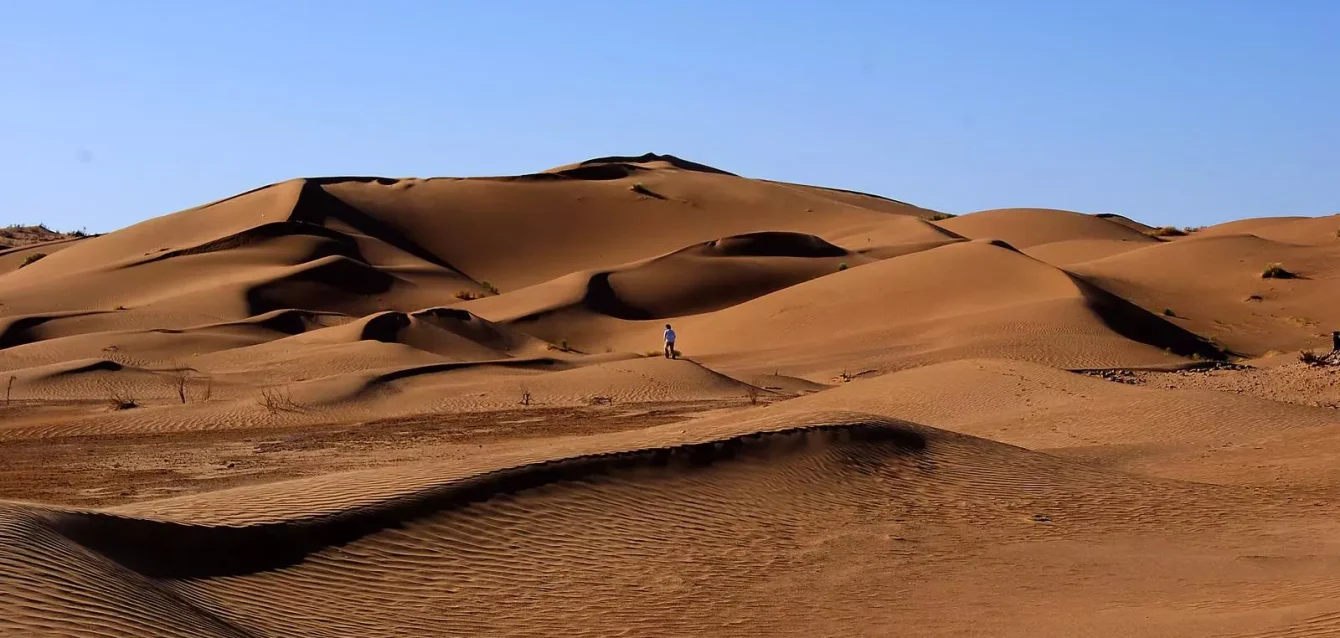The Karakum Desert consists of sandy, light soil, clayey, stony, gravelly, and saline soils. In the south, this vast plain, which abuts the beautiful valleys and rocks of the Kopetdag Mountains, is home to lakes, arid subtropical regions, stony, clayey, and gypsum plains, and vast expanses of sandy loam. The lands of the Central and Eastern Karakum, the Murgab and Tejen rivers, the Sandykly desert on the right bank of the Amudarya, and Uchtagan kum are more similar to each other. The lands between the valleys of the Amu Darya, Murgab, and Tejen rivers, north of Badkhyz and Karabil, in southwestern Turkmenistan or the northeastern part of the country are distinguished by their unique and original landscapes.
The soul of a person who has visited the desert once will always yearn for the silence of the lush sandy loam, where living creatures come into action only at night. When you think of the refreshing sand air of the Karakum sands, you are reminded of the salty breezes, the pungent smell of desert plants, and the rustling of reeds growing in the few blue lakes. Endless sand dunes stretch across the central Karakum. The dense vegetation around the lakes of Sarykamysh, Zengi Baba and others is typical of the northern desert. Here, after the saline areas have been cleared, towering groves of trees grow, creating unique desert jungles.
In a short time, participants in the “Amul-Hazar 2018” international auto rally, which will cross Turkmenistan from east to west, will be able to appreciate this beautiful landscape of the Karakum, get acquainted with its natural beauties and archaeological monuments of past times. They will be able to observe rare natural phenomena, unforgettable desert sunsets and the sunrise in the early morning, see the extremely different night and day climate of the Karakum, and the natural habitat of rare animals and plants.
The main route of the rally, the Karakum Desert, should attract the attention of the world community as a unique ecosystem worthy of inclusion in the UNESCO World Heritage List. Participants in the race have a rare opportunity to ride through the deserts of untouched wilderness.
Under the sand dunes of the Karakum lie dense takirs, salty and silty clays, gravel layers, sometimes soft saline or coarse sands, rocky areas. The height of the average sand dunes, the systems of which stretch for several kilometers, reaches thirty meters, and sometimes even higher.
The wind blows hot sands and “moves” them to places other than their “settled” places. The sands, carried by the wind to the sky, move from place to place, hovering over the tops of the plains, descending from the golden sand dunes, changing the landscape, creating a sandy haze in the air, enveloping the horizon in a blurry veil, creating a haze and bewitching travelers. Strong winds carry the average height of the Central Gargum up to six meters, and even further in the plains.
The desert landscape is a paradox: in spring, various colorful flowers and grasses resemble a carpet of flowers, but in summer they wither, in autumn, when it rains, they come to life again, and in winter they turn into a lifeless thing from a slightly cold state. Most plants have adapted well to the hot climate, dry summers and a slightly cold winter, and short-season plants growing in arid areas can set seed by early summer.
In the East, there is a saying: “He who has not seen the desert, does not know the universe.” In the depths of the Karakum Desert there are rich deposits of useful minerals, and although the surface is dry without water, there are water reserves under it. Nature itself helps soil scientists to determine whether the groundwater is fresh or salted, the main thing is to carefully observe the plants. For example, white saxaul grows on saline soil, while black saxaul grows widely in moderately saline areas. Halophytes – wormwood and saltwort – indicate the salinity of groundwater, and small shrubs indicate the presence of fresh water.
The deserts of Turkmenistan are studied in two nature reserves. The Repetek Biosphere Reserve has been operating for more than 90 years, a third of the plants here are unique species of the local flora, and six are endemic to a narrow range. Of mammals, there are rodents, and of reptiles – the steppe tortoise, the desert tortoise, and the arrow snake. Hundreds of species of birds and a hundred species of invertebrates can be found in different seasons. The history of Repetek dates back more than a hundred years. This unique desert scientific center was founded at one time by the Russian Imperial Geographical Society and its vice-president – the famous traveler PP Semyonov-Tyan-Shansky. In later times, soil scientist VV Dokuchaev, geologist and geographer VA Obruchev, the “father” of Russian genetics NI Vavilov, mineralogist AG Fersman, geomorphologist BA Fyodorovich, AG Babayev, who founded a unique scientific research institute for the study and development of deserts in Ashgabat, writer J. Darrell, as well as biologist NNDrozdov worked here.
Another is the Bereketli Garagum Desert Reserve, established in 2013 in the north of Ahal province on an area of more than 87 thousand hectares. The natural ecosystem includes sandy, loamy and saline deserts, as well as their mixed areas, which are the main breeding grounds of the heron. The protected areas are home to the eagle, sable, and gazelle, which are listed in the Red Book of Turkmenistan. There are valuable species of unique desert plants here, such as the Sogdian sedge, the sedge of the Maksimovich, and the Karakum sedge.

